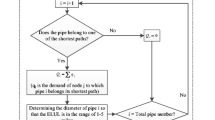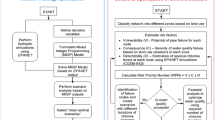Abstract
Hydraulic analysis of water distribution systems can be divided into DDA (Demand-Driven Analysis) and PDA (Pressure-Driven Analysis). Many studies have reported the superiority of the PDA over the DDA in the realistic simulation of hydraulic conditions under abnormal operating conditions. Many of the developed PDA models rely on iterative processes to solve the equations, which is a time-consuming task and even worse it is not possible to solve them in some cases. To improve the efficiency of the PDA, the present study proposes a new PDA model which interfaces a hydraulic simulator and an optimization algorithm with a customized searching scheme. The suggested model is applied to differently sized water distribution systems under abnormal operating conditions and its results are compared with ones by the DDA model and two other PDA models. As results, the DDA may generate unrealistic hydraulic results under the abnormal operating conditions while the three PDA models produce more realistic results. Moreover, the suggested PDA model with the new optimization process simulates the hydraulic conditions under the abnormal operating conditions in large water distribution systems efficiently compared to the other PDA models.
Similar content being viewed by others
References
Ackley, J. R. L., Tanyimboh, T. T., Tahar, B., and Templeman, A. B. (2001). “Head-driven analysis of water distribution system.” In: Ulanicki, B., Coulbeck, B. and Rance, J., editors, Water Software Systems: Theory and Applications, Vol. 1, Research Studies Press Ltd., Baldock, Hertfordshire, England, pp. 183–192.
Ang, W. K. and Jowitt, P. W. (2006). “Solution for water distribution systems under pressure-deficient conditions.” J. of Water Resour. Plan. and Manage., Vol. 132, No. 3, pp. 175–182.
Bentley Systems, Incorporated (2006). WaterGEMS v8 User Manual, 27 Siemon Co Dr, Suite200W, Watertown, CT06795, USA.
Bhave, P. R. (1981). “Node flow analysis of water distribution systems.” Transportation Engineering Journal of ASCE (Proc. of the ASCE), Vol. 107, No. TE4, pp. 457–467.
Chandapillai, J. (1991). “Realistic simulation of water distribution system.” J. of Transp. Eng., Vol. 117, No. 2, pp. 258–263.
Charles Howard and Associates, Ltd. (1984). Water distribution network analysis: SPD8 user’s manual, Charles Howard and Associates, Ltd., Victoria, B. C., Canada.
Fujiwara, O. and Ganesharajah, T. (1993). “Reliability assessment of water supply systems with storage and distribution networks.” Water Resour. Research, Vol. 29, No. 8, pp. 2917–2924.
Geem, Z. W. (2000). Optimal design of water distribution networks using harmony search, PhD Dissertation, Dep. of Civil and Envir. Eng., Korea Univ., Seoul, Korea.
Geem, Z. W., Kim, J. H., and Loganathan, G. V. (2001). “A new heuristic optimization technique: Harmony search.” Simulation, Vol. 14, No. 1, pp. 34–39.
Geem, Z. W., Kim, J. H., and Loganathan, G. V. (2002). “Harmony search optimization: Application to pipe network design.” International Journal of Modeling and Simulation, Vol. 22, No. 2, pp. 125–133.
Germanopoulos, G. (1985). “A technical note on the inclusion of pressure dependent demand and leakage terms in water supply network models.” Civil Eng. System, Vol. 2, No. 3, pp. 171–179.
Gessler, J. and Walski, T. M. (1985). Water distribution system optimization, Technical Report EL-85-11, Envir. Eng. Lab., U.S. Army Engineer Waterways Experiment Station, Vicksburg, MS.
Goulter, I. C. and Coals, A. V. (1986). “Quantitative approaches to reliability assessment in pipe networks.” J. of Transp. Eng., Vol. 112, No. 3, pp. 287–301.
Gupta, R. and Bhave, P. R. (1996). “Comparison of methods for predicting deficient-network performance.” J. of Water Resour. Plan. and Manage., Vol. 122, No. 3, pp. 214–217.
Holland, J. H. (1975). Adaptation in natural and artificial systems, Univ. of Michigan Press, Ann Arbor, Mich., USA.
Jun, H. D. and Loganathan, G. V. (2007) “Valve-controlled segments in water distribution systems.” J. of Water Resour. Plan. and Manage., Vol. 133, No. 2, pp. 145–155.
Kim, J. H., Zeem, J. W., and Kim, E. S. (2001). “Parameter estimation of the nonlinear muskingum model using Harmony search.” J. of American Water Res. Assoc., Vol. 37, No. 5, pp. 1131–1138.
Kim, J. H., Baek, C. W., Jo, D. J., Kim, E. S., and Park, M. J. (2004). “Optimal planning model for rehabilitation of water networks.” Water Science & Tech.: Water Supply, Vol. 4, No. 3, pp. 133–147.
Kirkpatrick, S., Gelatt Jr., C. D., and Vecchi, M. P. (1983). “Optimization by simulated annealing.” Science, Vol. 220, pp. 671–680.
Mays, L. W. (2003). Water supply systems security, McGRAW-HILL.
Mays, L. W. and Tung, Y. K. (1992). Hydrosystems engineering and management, McGraw-Hill.
Ozger, S. S. (2003). A semi-pressure-driven approach to reliability assessment of water distribution network, PhD Dissertation, Dep. of Civil and Envir. Eng., Arizona State Univ., Tempe, Arizona.
Paik, K. R. (2001). Development of seasonal tank model and comparison of optimization algorithms for parameter calibration, Mater Degree Dissertation, Dept. of Civil and Envir. Eng., Korea Univ., Seoul, Korea.
Paik, K. R., Kim, J. H., Kim, H. S., and Lee, D. R. (2005). “A conceptual rainfall-runoff model considering seasonal variation.” Hydrological Processes, Vol. 19, No. 19, pp. 3837–3850.
Reddy, L. S. and Elango, K. (1989). “Analysis of water distribution networks with head dependent outlets.” Civil Eng. System, Vol. 6, No. 3, pp. 102–110.
Reddy, L. S. and Elango, K. (1991). “A new approach to the analysis of water starved networks.” J. of Indian Water Works Assoc., Vol. 23, No. 1, pp. 31–38.
Rossman, L. A. (1994). EPANET users manual, Drinking Water Research Division, Risk Reduction Eng. Lab., Office of Research and Development, U.S. Envir. Protection Agency, Cincinnati, OH.
Su, Yu-Chen, Mays, L. W., Duan, N., and Lansey, K. E. (1987). “Reliability-based optimization model for water distribution systems.” J. of Hydra. Eng., Vol. 114, No. 12, pp. 1539–1556.
Tabesh, M., Tanyimboh, T. T., and Burrows, R. (2001). “Extended period reliability analysis of water distribution systems based on head driven simulation method.” Proc., World Water Congress 2001, ASCE, Orlando, Florida, USA.
Tabesh, M., Tanyimboh, T. T., and Burrows, R. (2002). “Head driven simulation of water supply networks.” Int. J. of Eng., Transactions A: Basics, Vol. 15, No. 1, pp. 11–22.
Tabesh, M., Tanyimboh, T. T., and Burrows, R. (2004). “Pressure dependent stochastic reliability analysis of water distribution networks.” Water Science and Technology: Water Supply, Vol. 4, No. 3, pp. 81–90.
Tanyimboh, T. T. and Tabesh, M. (1997a). “Discussion comparison of methods for predicting deficient-network performance.” J. of Water Resour. Plan. and Manage., Vol. 123, No. 6, pp. 369–370.
Tanyimboh, T. T. and Tabesh, M. (1997b). “The basis of the source head method of calculating distribution network reliability.” Proc., 3 rd international conference on Water Pipeline System, BHR publication, Hague, Netherlands.
Tanyimboh, T. T., Tabesh, M., and Burrows, R. (1997). “An improved source head method for calculation the reliability of water distribution networks.” Proc., The International Conference on Computing and Control for the Water Industry, Brunel Univ., UK.
Tanyimboh, T. T., Tabesh, M., and Burrows, R. (2000). “Appraisal of source head methods for calculation reliability of water distribution networks.” J. of Water Resour. Plan. and Manage., Vol. 127, No. 4, pp. 206–213.
Tanyimboh, T. T., Tahar, B., and Tabesh, M. (2003). “Pressure-driven modeling of water distribution systems.” Water Science and Technology: Water Supply, Vol. 3, No. 1–2, pp. 255–261.
Todini, E. (2006). “Toward realistic Extended Period Simulations (EPS) in looped pipe network.” Proc., the 8 th Annual Water Distribution Systems Analysis Symposium, Univ. of Cincinnati, Cincinnati, USA.
Wagner, J. M., Shamir, U., and Marks, D. H. (1988). “Water distribution reliability: Simulation methods.” J. of Water Resour. Plan. and Manage., Vol. 114, No. 3, pp. 276–294.
Walski, T. M. (1993). “Water distribution valve topology for reliability analysis.” Reliability Engineering & System Safety, Vol. 42, No. 1, pp. 21–27.
Wood, D. J. (1980). User’s manual-computer analysis of flow in pipe network including extended period simulation, Dept. of Civil Eng., Univ. of Kentucky, Lexington, KY.
Wu, Z. Y. and Walski, M. (2006). “Pressure-dependent hydraulic modelling for water distribution systems under abnormal conditions.” Proc., IWA World Water Congress and Exhibition, IWA, Beijing, China.
Wu, Z. Y., Wang, R. H., Walski, T. M., Yang, S. Y., and Bowdler, D. (2006). “Efficient pressure dependent demand model for large water distribution system analysis.” Proc., 8 th Annual International Symposium on Water Distribution System Analysis, ASCE, Cincinnati, Ohio, USA.
Author information
Authors and Affiliations
Corresponding author
Rights and permissions
About this article
Cite this article
Baek, C.W., Jun, H.D. & Kim, J.H. Development of a PDA model for water distribution systems using harmony search algorithm. KSCE J Civ Eng 14, 613–625 (2010). https://doi.org/10.1007/s12205-010-0613-7
Received:
Revised:
Accepted:
Published:
Issue Date:
DOI: https://doi.org/10.1007/s12205-010-0613-7




